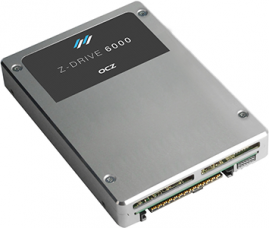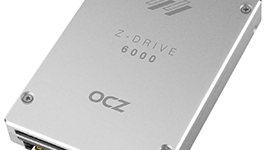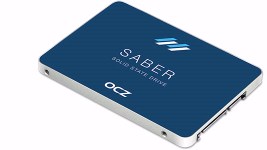Ralph Schmitt, CEO of OCZ answers our questions about his vision for the future of flash-based storage
1. Mr Schmitt, can you tell us more about OCZ’s enterprise product and market strategy?
OCZ has gone through a lot in the past couple of years which ended on a high note when Toshiba announced that it will be acquiring OCZ’s assets for $35 million. Since then OCZ has been operating as an independent subsidiary under Toshiba. Unlike what usually happens after acquisitions, OCZ has not been integrated to Toshiba’s existing units and all of OCZ’s different units (such as marketing, product development etc.) have remained intact. The OCZ-Toshiba relationship resembles more like a strategic partnership to be honest as that indicates how separate the two are, but only in a good way.
The reason why Toshiba wanted to keep OCZ independent was to ensure that the company’s talent doesn’t get buried into Toshiba’s massive organization. The common issue in acquisitions is that the acquiring company may not be able to use all the talent and resources of the acquired company because the culture of each organization can differ. In the end, individual talent isn’t just something concrete and absolute like money that can easily be transferred from one place to another — there are various environmental and cultural factors that go into it. For example, a change from liberal and relaxed culture to more tightly managed one can suppress some individuals because the way they work has to change, and the new way may not suit them. It is always a major challenge to integrate two companies with different organization cultures, so keeping the two separate is not always a bad idea.
Fortunately, Toshiba saw eye-to-eye with us and we just haven’t had enough time and resources to fulfill the potential. As a result, Toshiba decided to let OCZ continue its business and R&D as a separate unit by providing financial support for the company. The new OCZ had, and still has, a sustainable business plan, so there was no reason to break up the company into pieces.
The companies have also gone through the process of unifying product roadmaps. Initially, there was quite a bit of overlap because both had their own lineups and tried to cover as much of the market as possible, but by mid-2015 there should no longer be any major product overlaps. For instance, OCZ has stopped all SAS development as Toshiba has more expertise in that field and the same goes for certain OEM drives where Toshiba has always had a strong presence. At the same time, Toshiba will let OCZ handle the OCZ branded retail sales and on the enterprise side OCZ’s focus will be in SATA and PCIe drives. The idea and goal is to supplement each other’s lineup, not to compete.
2. How has OCZ’s time to market improved since Toshiba’s acquisition?
As part of the Toshiba Group, OCZ is now able to leverage a number of Toshiba’s labs and run much more extensive testing throughout the design cycle, as well as do more specialized testing and validation to meet specific customer requirements. During the baby steps of the acquisition, the companies had a few different philosophies when it came to validation, which makes sense given the different backgrounds. For instance, Toshiba might focus more on the NAND during testing/validation (Toshiba is the inventor and major supplier of NAND, after all), whereas OCZ would focus on other
aspects we could impact like the controller and firmware first.
The companies have then aligned their philosophies to use the same thinking during product development and testing. Toshiba holds OCZ drives to the same quality standards as its own and OCZ has adopted many of Toshiba’s processes for its quality control. The testing/validation aspect is just one example of how the two companies are supplementing each other. The key here is that both companies have and are still learning from each other to ensure that both companies are putting out the best possible products.
The one major advantage OCZ has gained is access to Toshiba’s NAND knowhow. At the high level NAND is a fairly simple semiconductor (you apply a high voltage that creates an electric field that forces electrons to tunnel from the channel through the silicon oxide to the floating gate), but once you get down to the atomic level it becomes a highly complex piece of technology. Some of OCZ’s engineers have been living in Japan since the acquisition and just learning things about NAND and its characteristics to help build better products. In this case, especially endurance tweaks that require a very deep understanding of NAND, so having access to that knowledge and applying it to product design will provide OCZ with a very important advantage in the market.
Another crucial element that Toshiba provides is the access to its NAND supply. In the past OCZ had to source NAND from the open market, which resulted in varying quality NAND being used. Like many components (and goods/stocks in general), NAND is sold on spot market where anyone can sell or buy NAND. In case a NAND manufacturer (or any company) has excess stock, they can dump a portion of that into the spot market and sell it at the day’s price. It is possible to buy NAND straight from the manufacturer, but the required volume tends to be fairly high and in turn you don’t get the benefits of the dynamic spot market (predicting supply/demand and the associated price changes can be very profitable, if successful).
3. Along the same lines, how has your R&D evolved?
I would regard OCZ as the one-stop-solution for the demanding storage needs. We control all the aspects of the technology. Our flexibility to customize the solutions according to the client’s needs in multiple places on the value chain gives us a leading edge in this competitive market. Moreover like answered in question two, its parent company Toshiba’s leadership in NAND flash memory segment gives OCZ the access to next-gen solutions.
Aside from high-level roadmap comparison, there is cooperation in individual products too. For a TLC NAND based SSD, the companies decided that it’s better to let Toshiba handle the development of that drive because the company has been developing one for quite some time now and building a competitive TLC SSD requires a hefty amount of NAND knowledge, which is Toshiba’s area of strength. It simply makes sense to focus all resources on one platform instead of having OCZ and Toshiba both spend money on a design that ultimately has the same end goal. However, for the first time, the Toshiba-built TLC drive will also retail under OCZ brand, which makes sense as OCZ already has a widespread distribution network and the required support for retail sales. On the other hand, Toshiba is very interested in OCZ’s upcoming JetExpress controller, so I wouldn’t be surprised to see Toshiba branded SSDs with the JetExpress controller for OEMs.
There is no substitute for quality
While OCZ has transitioned manufacturing operations to a Toshiba certified partner (PTI), a robust engineering team leverages innovative IP to design and develop differentiated flash storage solutions. Quality is embedded in the entire design cycle with supplier qualification and monitoring, meet ISO 9001:2008 certification.
Today, OCZ is focused on delivering the right balance of performance and quality ensuring superior reliability for customers. Quality is a priority in everything we do and this is highlighted throughout the organization to remind us what our #1 job is as a company. We’ve made significant improvements and investments to ensure quality throughout the organization. As result, the return/defective rates have and continue to drop significantly. Current products have an overall return rate of just 0.57%* whereof 0.31%* turned out to be really defective, for example only 0.05% confirmed failures of Vector 150.
* Data reflects active products as of December 15, 2014
Today, OCZ is very different from yesterday’s OCZ. The management has changed the course to a sustainable path where focus is on long-term development and proper validation. The Toshiba partnership just further emphasizes the quality aspect and also gives OCZ the much needed NAND supply and knowledge access.
4. How do you see the Flash storage market evolve in the next 5 years?
There are several good interfaces available for enterprise SSDs but PCIe has become one of the best. Its direct connection to the host CPU provides ‘near-zero’ latency. The current PCIe 3.0 version provides 1GB/s of bandwidth per lane enabling PCIe SSDs to use 4 or 8 lanes concurrently, equating to 4GB/s or 8GB/s of achievable bandwidth from each device.
Today’s enterprise servers have several PCIe slots available for SSD deployment and can accommodate up to 40 lanes of PCIe per CPU. A two-socket server can support 80 lanes of PCIe. With an ongoing performance gap between server processors and HDD subsystems, PCIe-SSDs are highly desirable and represent a fast-growing multi-billion dollar global opportunity over the next five years. At present, PCIe SSD deployments are at introductory levels.
To achieve these expected deployment levels, PCIe required a host-controlled interface standard. Without this, each SSD vendor has to develop their own proprietary drivers on how the SSD will interface with the host. By standardizing the interface, only one driver development is required. As such, the Non-Volatile Memory Express (NVMe) specification was created to deliver the full potential of non-volatile memory for enterprise and client platforms in support of PCIe-based SSDs. NVMe is a very hot topic and we should dive deeper into that in a specialized topic.
We believe that the future lies in PCIe/NVMe, and our innovation lab is currently focusing on that. With the emergence of cloud computing, big data, virtualization and mobility, the data storage sector is going through a metamorphosis of its own. As a result, SSDs based on NAND flash memory chips, have emerged as the cardinal of storage interfaces, thus diminishing the hard drive market. We lead this transformation from hard drives to SSDs by offering application specific solutions. OCZ’s flash-based storage and software solutions offer increased performance and responsiveness for a wide range of usage models and workloads, from virtualization to large-scale data centers to cloud computing. For example, our ZDXL PCIe solid state solution, which is an integration of hardware and software, can enhance performance of a SQL Server database environment,” claims Schmitt.
Striving to eliminate storage inefficiencies, OCZ’s SSDs take storage technology to the next level. We believe in amalgamating two basic factors in our solutions—cost and performance. In other words, to meet the performance requirements in a cost effective way and enhance the total computing experience. The company’s broad portfolio of SSD solutions includes several interfaces and enterprise feature-sets that enable unprecedented flexibility and efficiency for high throughput systems. Each solution is designed and built with the highest level of quality and reliability that enterprises and OEMs can count on for business-critical applications.
OCZ’s ability to marry high performance with cost effectiveness comes from the company’s long stint with the high performance computing and gaming industries. We already have a strong foothold in the gaming market, where it is important to push performance at low cost. We are looking forward to spark the same strategy in the enterprise world.
Let’s give you also an interesting example that reflects our expertise: 888.com, one of the world’s most popular online gaming providers was facing problems with their traditional data center and network with several I/O bottlenecks. Since multiple players access the resources at the same time, the key challenge was to reduce database I/O pressure on the SAN and improve the SQL server database performance. We simplified their storage system using our PCIe-based ZD-XL SQL Accelerator. OCZ also reduced the I/O load on the SAN by 50 percent thus alleviating the workload pressure and enhancing the efficiency of application data. We limited the problems and improved the SQL Server data throughput by 150 percent.
5. … And compared to the mechanical HDD market?
Opportunities continue to unfold in the enterprise for flash-based solid-state storage as they provide faster I/O performance than hard disk storage, support large capacities and a variety of form factors and interfaces, and consume less power. The amount of data stored within enterprises and by client users has reached astronomical proportions creating a need to deliver data even faster and more efficiently.
Saying Flash-Drives will replace HDD completely will not be the right approach. Of course there will be Flash-only environments, when highest performance is required. But more often we will see a combination of both, as HDDs are still the medium to archive data the most affordable way. This will not change anytime soon.
6. What will be OCZ’s next big product launch?
With the increase of enterprise applications, SSDs have become an essential technology to ensure predictable delivery of Read I/O to the application layer. Failing to match such capabilities leads to increased workload and reduced performance.
One of OCZ’s recently launched flagship storage solutions, the Saber 1000 Series, is a new class of enterprise SATA SSDs designed for read-intensive applications targeting high-volume deployment hyperscale, web-hosting and distributed computing environments.
Customers asked, we delivered. Recently OCZ announced the addition of a new enterprise SSD line to the Intrepid 3000 portfolio, the 3700 Series. Intrepid 3700 drives were specifically designed to deliver maximum usable capacity with no sacrifices in performance or endurance. It sounds too good to be true, but Intrepid 3700 SSDs provide a storage architect with the best of both worlds: ample storage and ample DWPD (Drive Writes Per Day).
Lastly, OCZ’s PCIe solution Z-Drive 4500 is a full-featured flash solution that integrates robust performance, reliability, data protection, and monitoring functions for critical enterprise applications and demanding big data environments. After one OCZ Enterprise customer found themselves contending with data traffic their current storage architecture could not handle, they turned to OCZ Z-Drive 4500 SSDs to increase performance for their users.
Our very exciting next-generation NVMe-compliant Z-Drive 6000 PCIe SSD Series is currently in the evaluation state and will be launched in the second half of 2015. It is a native PCIe 3.0 NVMe 1.1b solution designed in an easy-to-deploy 2.5-inch form factor that not only delivers extremely high performance and near-zero latency, but also features a hot-pluggable SFF-8639 connector for easy deployment and superior serviceability. Catering to both the enterprise and consumer markets, OCZ’s recently unveiled JetExpress SSD controller technology will be on display. Designed and developed in-house, JetExpress will be the heart and soul of OCZ’s future product line being native SATA and PCIe/NVMe, supporting multiple form factors including M.2 and 2.5-inch SATA.
All in all, OCZ feels to be on the right path. The product roadmap, and especially the new JetExpress PCIe controller looks very promising and we are convinced the potential ends up being well executed. We are working continuously in earning back the consumers’ trust, including those that received an unreliable drive in the past. We know this will take time. But the new OCZ has been injected with a new attitude and more resources when it comes to testing and validation. And we will show our expertise and innovation with our next generation products – so stay tuned!
© HPC Today 2024 - All rights reserved.
Thank you for reading HPC Today.

































